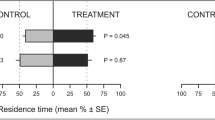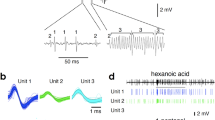Abstract
ALTHOUGH numerous theories of olfaction and gustation1–8 have been published, there is little experimental evidence on the energy-transfer mechanisms involved in the interactions of chemical messengers with proteinaceous receptors of sensory neurones. One such mechanism, involved in the inhibition of feeding of Periplaneta americana and Scolytus multistriatus by various 1,4-naphthoquinones, has been extensively studied and partially interpreted behaviourally9–16, ultrastructurally10–16, electrophysiologically10–16 and biochemically10–16. These messenger naphthoquinones were shown to act through a selective reaction with sulphydryl10–16 groups in a particular membrane-associated receptor macromolecule which was proven to be physically accessible in situ17 to these chemicals through cuticular pores and tubules10–16 in the walls of chemoreceptor sensillae on the insect's antennae. This specific energy transfer resulted in disulphide-bond formation or thiol complexing10–16, both of which are proven18 mechanisms in certain proteins for causing conformational changes. Such changes can alter the cationic permeability of macromolecules composing membranes18. The messenger-altered cation permeability of the receptor thus can result in the generation of action potentials in the sensory neurone10–16. Here we report certain physicochemical characteristics of the messenger-naphthoquinone receptor protein interactions as analysed in a deoxygenated system at physiological pH by the in vitro technique of dropping mercury electrode (DME) polarography (PO4 ‘Polariter’, London Co.). The polarogram is a current–voltage curve obtained by applying a gradually increasing voltage to a system and measuring the current flow at each potential. Characteristic polarographic half-wave potential (that is, E ½) values for proteins were attributed exclusively to exposed, reactive sulphydry1, or reducible disulphide, groups19–22. In our own investigations, the ‘Triton’ X-100-solubilized quinone-reactive receptor protein from the cockroach antennae gave a characteristic E ½ of −1,860 mV. A control (non-quinone receptor) protein system composed of the saline-soluble proteins from the same antennae gave an E ½ of −1,800 mV. Adding messenger 5-hydroxy-1,4-naphthoquinone (5 × 10−5M) in the receptor preparation characteristically shifted the E ½ from −1,860 to −1,880 mV; another less repellent, or feeding-inhibitory, messenger, 2-methyl-1,4-naphthoquinone (5 × 10−5 M), only shifted the receptor E ½ to −1,875 mV. Neither of these messenger quinones altered the −1,800 mV E ½ of the non-receptor control protein. N-Ethyl maleimide (NEM), a highly specific thiol reagent, at 5 × 10−5 M in the receptor preparation shifted the E ½from −1,860 to −1,890 mV. In this −1,890 mV state, the receptor was non-reactive with messenger quinones. Treatment of the receptor in the −1,890 mV state with the disulphide reducing agent, dithiothreitol (DTT), brought the E ½ of the receptor back down to −1,860 mV. In this restored −1,860 mV state, the receptor again reacted with messenger quinones.
This is a preview of subscription content, access via your institution
Access options
Subscribe to this journal
Receive 51 print issues and online access
$199.00 per year
only $3.90 per issue
Buy this article
- Purchase on Springer Link
- Instant access to full article PDF
Prices may be subject to local taxes which are calculated during checkout
Similar content being viewed by others
References
Moncrieff, R. W., The Chemical Senses, 760 (CRS Press, Cleveland, 1967).
Hornstein, I., Flavor Chemistry, Advances in Chemistry Series 56, 278 (American Chemical Society, Washington, 1966).
Schultz, H. W., Day, E. A., and Libbey, L. M., Symposium on Foods: The Chemistry and Physiology of Flavors, 552 (AVI Publishing Co., Westport, Connecticut, 1967).
Davies, J. T., J. theor. Biol., 8, 1 (1965).
Dravnieks, A., Nature, 194, 245 (1962).
Amoore, J. E., Cold Spring Harbor Symp. quant. Biol., 30, 623 (1965).
Beidler, L. M., Ann. NY Acad. Sci., 58, 52 (1954).
Wright, R. H., Nature, 173, 831 (1954).
Norris, D. M., Ferkovich, S. M., Rozental, J. M., Baker, J. E., and Borg, T. K., Science, 170, 754 (1970).
Norris, D. M., Baker, J. E., Borg, T. K., Ferkovich, S. M., and Rozental, J. M., Contrib. Boyce Thomp. Inst., 24, 263 (1970).
Norris, D. M., Nature, 222, 1263 (1969).
Norris, D. M., Ferkovich, S. M., Baker, J. E., Rozental, J. M., and Borg, T. K., J. Insect Physiol., 17, 85 (1971).
Borg, T. K., and Norris, D. M., Ann. ent. Soc. Am., 64, 544 (1971).
Ferkovich, S. M., and Norris, D. M., Chem. Biol. Interactions, 4, 23 (1971/1972).
Baker, J. E., and Norris, D. M., J. Insect Physiol., 17, 2383 (1971).
Baker, J. E., and Norris, D. M., Experientia, 28, 31 (1972).
Ferkovich, S. M., and Norris, D. M., Experientia, 28, 978 (1972).
Rothstein, A., in Current Topics in Membranes and Transport, 243 (Academic Press, London and New York, 1970).
Brdička, R., Coll. Czech. chem. Comm., 5, 112 (1933).
Brdička, R., Coll. Czech. chem. Comm., 5, 148 (1933).
Brdička, R., Coll. Czech. chem. Comm., 5, 238 (1933).
Brdička, R., Coll. Czech. chem. Comm., 8, 366 (1936).
Lowry, O. H., Rosebrough, N. J., Farr, A. L., and Randall, R. J., J. biol. Chem., 193, 265 (1951).
Norris, D. M., Experientia, 27, 531 (1971).
Changeaux, J. P., and Thiéry, J., in Regulatory Functions of Biological Membranes, 311 (Elsevier, Amsterdam, 1968).
Author information
Authors and Affiliations
Rights and permissions
About this article
Cite this article
ROZENTAL, J., NORRIS, D. Chemosensory Mechanism in American Cockroach Olfaction and Gustation. Nature 244, 370–371 (1973). https://doi.org/10.1038/244370a0
Received:
Issue Date:
DOI: https://doi.org/10.1038/244370a0
This article is cited by
-
10.1007/BF00354217
CrossRef Listing of Deleted DOIs (2011)
-
Antioxidant alteration ofGlycine max (Fabaceae) defensive chemistry: Analogy to herbivory elicitation
Chemoecology (1992)
-
?-Tocopherol alteration of soybean antiherbivory toTrichoplusia ni larvae
Journal of Chemical Ecology (1991)
-
Periplaneta americana perception of phytochemical naphthoquinones as allelochemicals
Journal of Chemical Ecology (1988)
-
Insect antifeedant terpenes, hot-tasting to humans
Experientia (1981)
Comments
By submitting a comment you agree to abide by our Terms and Community Guidelines. If you find something abusive or that does not comply with our terms or guidelines please flag it as inappropriate.



